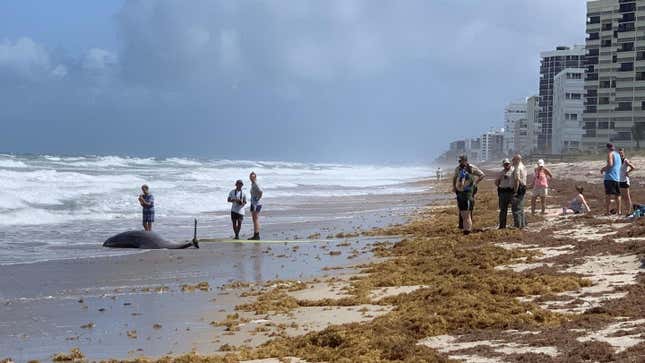
New research shows the startling degree to which stranded dolphins and whales found along the southeastern U.S. coast are contaminated with pollutants.
BPA, DEP, NPE, atrazine, and triclosan—these are a few of our not-so-favorite things, and as new research published in Frontiers in Marine Sciences shows, these human-created toxins are appearing at high levels among whales and dolphins stranded along the southeastern coast of the United States, namely Florida and South Carolina. The strandings could not be directly attributed to these contaminants, but the poor health of some animals shows the unacceptable degree to which pollution is harming marine food webs.
These toxic substances enter the marine ecosystem either directly or as polluted runoff, coming from such sources as fossil fuel and chemical spills, fertilizers, detergents, packaging, septic tanks, farms, and plastics. Once in the ocean, these contaminants linger, posing serious health risks to marine animals. Documenting pollutants in whales and dolphins “is a critical step in tracing chemical contaminants within the marine food web and understanding their effects on biological systems,” wrote the authors.
“We must do our part to reduce the amount of toxicants that enter into our marine environment, which have important health and environmental implications not just for marine life but for humans,” Page-Karjian, the lead author of the new paper and a researcher from the Harbor Branch Oceanographic Institute at the Florida Atlantic University, said in a press release. “These chemicals work their way up through the food chain and get more concentrated the higher up they go. When dolphins and whales eat fish with concentrations of the chemicals, the toxic elements enter their bodies. Dolphins eat a variety of fish and shrimp in these marine environments and so do humans.”

For the new study, Page-Karjian, along with her colleagues, measured levels of toxins in 83 toothed whales found stranded along beaches in Florida and South Carolina from 2012 to 2018. These toothed whales included 11 different species, such as dolphins, porpoises, beaked whales, and sperm whales. Of these stranded animals, 33 had to be euthanized by wildlife officials; 23 had died recently; 26 were “moderately decomposed;” and one was released back into the wild after a tissue sample was taken using local anesthesia.
In total, the researchers tested for 17 different substances, including organic toxins, essential elements, and non-essential elements.
Organic toxins included atrazine (a herbicide), bisphenol A (commonly known as BPA, and as found in polycarbonate plastics and epoxy resins), diethyl phthalates (also known as DEP, a phthalate ester), nonylphenol monoethoxylate (known as NPE, which is commonly found in food packaging), and triclosan (an antimicrobial ingredient). As the authors note, “this is the first published report examining concentrations of atrazine, DEP, NPE, and triclosan in blubber tissues of stranded cetaceans.”
Non-essential elements included arsenic, cadmium, lead, mercury, thallium and essential elements included cobalt, copper, manganese, iron, selenium, and zinc.

The researchers used a mass spectrometer to detect toxins in blubber samples taken from the stranded animals, while liver samples were used to detect both the essential and non-essential elements. Necropsies were also performed on the animals to determine factors like age, sex, and potential health problems at the time of death.
The levels of contaminants seen in these animals varied according to species, sex, age, nutritional and reproductive status, foraging areas, and location.
Bottlenose dolphins, for example, had higher levels of lead, manganese, and mercury and lower levels of NPE, arsenic, iron, and cadmium, compared to samples taken from pygmy sperm whales. Concentrations of BPA and triclosan were highest in bottlenose dolphins, while NPE and BPA were highest in pygmy sperm whales. Also, adult female bottlenose dolphins had higher levels of arsenic and lower levels of iron than adult males. In general, adult bottlenose dolphins had higher levels of contaminants than juveniles. It’s possible that the older animals accumulated higher levels of lead, mercury, and selenium through eating fish, according to the study.
In terms of geography, stranded dolphins in Florida exhibited significantly higher concentrations of lead, mercury, and selenium and lower concentrations of iron, compared to their North Carolinian counterparts. This probably has something to do with the animals’ proximity to the source of the toxicants.
Necropsies done on 72 stranded dolphins and whales focused on organ systems most likely to be affected by chronic exposure to toxicants, including the nervous, cardiovascular, and lymphatic systems. Fibrosis, hepatitis, neoplasia (abnormal growth of cells), and lymphoid and thyroid dysfunction were among the many health issues documented in these animals.
An adult male white-beaked dolphin was in particularly bad shape, exhibiting signs of fibrosis, lymphoid depletion in the spleen, neoplasia (including a cell tumor in the testicles), and several other diseases and disorders. This individual happened to have the highest concentration of BPA measured in this study and relatively high concentrations of DEP and triclosan.
The researchers said it wasn’t possible to definitively connect contaminant exposure with the various health issues seen in these animals or the strandings themselves, but pollutants shouldn’t be ruled out or ignored. By examining the chemicals found in these animals, “we can begin to better understand some of the potential health impacts that exposure to these compounds can have on vulnerable and understudied species like cetaceans,” wrote the authors.
This study is yet another wakeup call to keep our oceans free of dangerous pollution and other waste products.